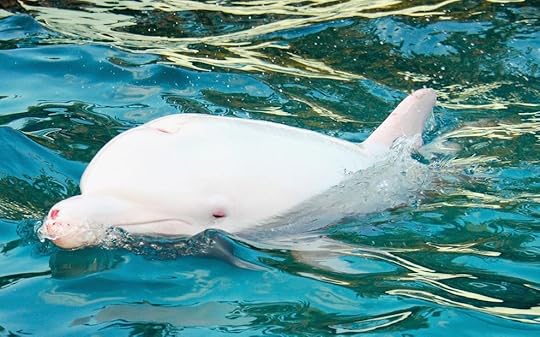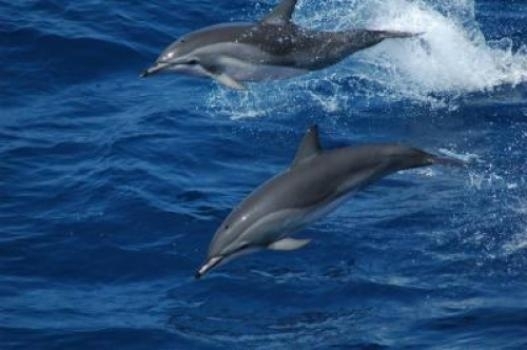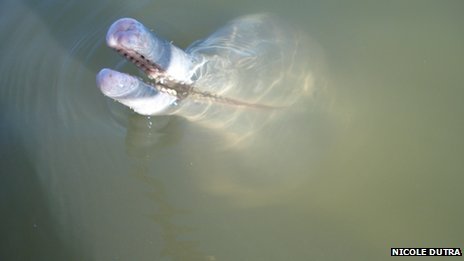Mark Caney's Blog, page 29
February 12, 2014
Japanese dolphin fishermen “invite Kennedy to see hunt for herself”
From THE ASAHI SHIMBUN: TAIJI, Wakayama Prefecture, Japan
A senior official connected with the seasonal dolphin hunt here is defending the tradition as painless to the small cetaceans and is inviting U.S. Ambassador to Japan Caroline Kennedy to see for herself.
The tweet by Kennedy last month criticizing the dolphin drive hunt in the town of Taiji has cast a fresh spotlight on the controversial practice.
“The method (of killing) causes them no pain,” said Yoshifumi Kai of the Taiji Fishermen’s Cooperative. “We would like Ambassador Kennedy to come and visit to see the hunt for herself.”
Kai said fishermen in Taiji switched more than 10 years ago to a method that uses a 30-centimeter pick to kill them almost instantaneously.
In her tweet on Jan. 18, Kennedy lambasted the herding and killing of the dolphins by local fisherman, saying, “Deeply concerned by inhumaneness of drive hunt dolphin killing. USG (U.S. government) opposes drive hunt fisheries.”
Taiji is the only place in Japan where dolphins are herded into an enclosure where they are then slaughtered.
The dolphin season begins in September, lasting for about six months. About 1,000 dolphins are harvested each year.
The hunt involves a small fleet of boats sailing into nearby waters in search of dolphin pods.
Once one is spotted, the fishermen use metal rods, which they stick into the water and bang with a hammer to produce a noise to herd the dolphins into a small cove. Nets are used to block their escape.
The dolphin harvest in Taiji was thrust into global spotlight following the release of the film “The Cove,” which documented the hunt and went on to win an Academy Award in 2010.
The footage showing the waters turning red as the fishermen harpooned the dolphins drew international criticism.
Some people said the animals looked to be in pain. They also called the method inhumane because it sparked panic among the dolphins.
Following Kennedy’s tweet, U.S. media outlets began reporting on the dolphin hunting once again in a critical tone.
Coverage by CNN soon after the ambassador’s criticism included the warning, “Warning, graphic video,” when footage of the hunt was aired.
The United States’ Marine Mammal Protection Act of 1972 tightly regulates whale and dolphin hunting, making some exceptions for minority populations whose forefathers traditionally hunted whales.
Some say Americans react more sharply to the hunting for dolphins, compared to whales, because dolphins are regarded as one of man’s best friends, given their high levels of intelligence.
Taiji is believed to be the cradle of Japan’s tradition of whale hunting. The nation’s first organization specializing in whale hunting was set up in the town in 1606.
Taiji Mayor Kazutaka Sangen tried to defend the whale hunt by explaining its origins.
“Our ancestors hunted whales for their very survival,” said Sangen, whose grandfather was the captain of a whaler. “Our history of whale hunting is different from that of the United States and European countries.”
In fact, the United States was at one time the world’s largest whale-hunting nation. That was until the middle of the 19th century when whale oil was a crucial source of fuel.
Commodore Matthew Perry’s “Black Ships,” which helped end Japan’s isolationism, arrived in Japan in 1853 and 1854 reportedly to secure port privileges for American whalers.
Eventually, whale hunting began to decline in the United States and Europe, where they are now a protected species.
Dolphin hunting in Taiji is relatively new, though. The first dolphin hunts were conducted to catch rather than kill the sea mammals for an amusement show performed at the municipal Taiji Whale Museum, which opened in 1969. Even in recent years, around 100 dolphins a year are captured alive, to sell to other aquariums around Japan.
Since the dolphin hunt has drawn the attention of international animal protection groups, a little more than 10 foreigners visit the town daily, which has a population of about 3,500 people.
Most are members of the anti-whaling Sea Shepherd Conservation Society, who also call themselves the Cove Guardians.
They often take video of the dolphin hunt to release on the Internet in order to draw attention to the practice. They also regularly warn against eating dolphin meat, saying it contains high levels of mercury.
Some townspeople, too, are critical of the dolphin hunt.
“We don’t need to continue with the hunting, with all the criticism from the world,” said one resident.
But one of the fishermen said the hunt is an important source of income for local residents.
“Dolphins are big fish for us,” he said. “We go to sea to make our livelihoods by catching dolphins.”
(This article was written by Takayuki Kihara and Tetsu Kobayashi.)
Source: ASAHI SHIMBUN

February 11, 2014
Despite facing multiple threats, Indus dolphin population grows

Workers remove a blind dolphin from the Khairpur Canal to free it at Lansdowne Bridge in order to shift them into deeper waters.
The blind Indus dolphin – an endangered species indigenous to the river in Pakistan – has been on the brink of extinction due to pollution, climate change, excessive fishing, poisonous chemicals and water shortage in the river. However, their numbers are slowly growing again.
According to a survey conducted by the World Wide Fund for Nature (WWF) in 2011, only 1,452 blind Indus dolphins remain in the river. Out of these, 96 dolphins were found between Chashma and Taunsa barrages, 465 were found between Taunsa and Guddu barrages, 857 between Guddu and Sukkur barrages and 34 were found between Sukkur and Kotri barrages. According to the WWF, the surveys are conducted every five years.
Expert opinion
The pollution in the River Indus is affecting the dolphins along with the fishes and even human beings who eat these fish. The fishermen add poisonous chemicals into the water in order to catch more fish with ease.
Talking to The Express Tribune, Sukkur wildlife department deputy conservator Ghulam Muhammad Gadani said that only three dolphins were killed in 2013, while 30 were killed in 2012 – a majority of which were due to excessive fishing and dumping of poisonous chemicals. “This shows that our campaign to raise awareness is working,” he said. “In the past, fishermen also used to dump poisonous chemicals into ponds that ended up in the Indus river. However, this year we have not had that problem.”
Gadani added that the use of pesticide is also contributing to water pollution while lamenting that it is now considered commonplace to dump waste into the river. “Nobody observes environment protection laws anymore,” he felt. “There needs to be strict implementation of these laws if we want to save endangered species from extinction. Dumping industrial and residential waste into the river has become habitual.”
However, Gadani felt that rather than blaming the general population, the focus should be on educating them about the wildlife. “Our people kill animals like crocodiles, leopards and water otters. They need to be made aware about the fact that these animals are endangered and should therefore not be harmed.”
Sukkur Dolphin Centre incharge Mir Akhtar Talpur told The Express Tribune that the natual habitat of the Indus dolphin is between the Jinnah Barrage near Kalabagh and the Kotri Barrage. “Excess fishing is posing a threat to all animals in the Indus River, including the Indus dolphin,” he added. “The Indus dolphin is similar to another species that is found in South America, China and India. However, the Indus dolphin is set apart from them due to its blindness. The blind dolphin is found only in the River Indus.”
Talpur then revealed that the dolphin breastfeeds its kids for three months before they are able to start hunting on their own.
“The total population of the dolphin in River Indus is increasing but the growth is very slow,” he revealed. “The average age of a healthy Indus dolphin ranges from between 25 to 30 years. They are fragile mammals and often die of heart attacks. ”
While talking about how the dolphin copes with being completely blind, Talpur said that it is blessed with a radar-like sonar system which it uses to hunt and navigate. “The Indus dolphin is a very friendly and harmless creature but it cannot be trained like other marine dolphins since it cannot see and therefore cannot follow the gestured instructions of dolphin trainers.”
Source: The Express Tribune

January 30, 2014
Uncertain Fate Awaits Rare Calf Captured in Japanese Dolphin Hunt
 A rare albino dolphin calf, rounded up in a dolphin hunt off of Japan earlier this month, is now on display at a Japanese whale museum, where experts say its long-term survival is in doubt.
A rare albino dolphin calf, rounded up in a dolphin hunt off of Japan earlier this month, is now on display at a Japanese whale museum, where experts say its long-term survival is in doubt.
The dolphin, a female believed to be less than a year old, was part of the Taiji dolphin hunt that drew global media coverage and outrage from animal protection advocates.
“Albinos stand out and tend to be targeted by predators,” said Taiji Whale Museum Assistant Director Tetsuya Kirihata in a statement, according to some media reports. “She must have been protected by her mother and her mates. We will take good care of her.”
But that may be difficult, according to Stan Kuczaj, director of the Marine Mammal Behavior and Cognition Laboratory at the University of Southern Mississippi.
“Calves that have stranded for various reasons have sometimes been nursed back to health by humans, but others have died,” Kuczaj said. “So the calf could survive, but that is certainly not guaranteed.
“We know little about the effects of trauma [and] stress on young marine mammals, but it seems likely that this calf was very stressed by the hunt and so could be at even greater risk,” he continued, “especially since it was separated from its mother.”
Efforts to reach the Taiji Whale Museum directly were unsuccessful.
Animal advocates quickly dubbed the dolphin “Angel” in an effort to draw the world’s sympathy to what they say is the brutality of dolphin hunting.
The young albino calf proved attractive to Taiji’s dolphin brokers, who sell captured dolphins from Taiji to marine parks across Asia and beyond.
According to the animal-protection group Sea Shepherd Conservation Society, which closely monitors the Taiji drive hunts, the albino was the first dolphin selected for capture and sale.
Naomi Rose, a dolphin and killer whale expert at the Animal Welfare Institute, said that despite assurances from the museum about the calf’s safety, the young dolphin shouldn’t be there in the first place: “Taking a dependent calf goes against every established conservation principle there is.
“It was wrong ethically, biologically, and in terms of management,” she said. “It was wrong on every level and just plain cruel.”
Full story: National Geographic

January 28, 2014
Natural hybridization produced dolphin species
A newly published study on the clymene dolphin, a small and sleek marine mammal living in the Atlantic Ocean, shows that this species arose through natural hybridization between two closely related dolphins species, according to authors from the Wildlife Conservation Society, the American Museum of Natural History’s Sackler Institute for Comparative Genomics, the University of Lisbon, and other contributing groups.

In a molecular analysis including the closely related spinner and striped dolphins, scientists conclude that the clymene dolphin is the product of natural hybridization, a process that is more common for plants, fishes, and birds, but quite rare in mammals.
The study appears in the online journal PLOS ONE. The authors include: Ana R. Amaral of the University of Lisbon, Portugal, and the American Museum of Natural History; Gretchen Lovewell of the Mote Marine Laboratory; Maria Manuela Coelho of the University of Lisbon; George Amato of the American Museum of Natural History; and Howard Rosenbaum of the Wildlife Conservation Society and American Museum of Natural History.
“Our study represents the first such documented instance of a marine mammal species originating through the hybridization of two other species,” said Ana R. Amaral, lead author of the study and research associate at the American Museum of Natural History. “This also provides us with an excellent opportunity to better understand the mechanisms of evolution.”
The classification of the clymene dolphin has been a longstanding challenge to taxonomists, who initially considered it to be a subspecies of the spinner dolphin. Then in 1981, thorough morphological analyses established it as a recognized distinct species. In the current study, researchers sought to clarify outstanding questions about the dolphin’s origin and relationships with rigorous genetic analyses.
“With its similar physical appearance to the most closely related species, our genetic results now provide the key insights into this species origin” said Dr. Howard Rosenbaum, Director for WCS’s Ocean Giants Program and a senior author on the study. “Very little is known about the clymene dolphin, whose scientific name translated from Greek is oceanid, but ironically also can mean fame or notoriety. Hopefully, our work will help draw greater attention to these dolphins in large parts of their range.”
Full story: Science Daily, source: Wildlife Conservation Society

January 27, 2014
Dolphins steal show from surfers
January 26, 2014
Brazil dolphin is first new river species since 1918

Scientists in Brazil have discovered the first new river dolphin species since the end of World War One.
Named after the Araguaia river where it was found, the species is only the fifth known of its kind in the world.
Writing in the journal Plos One, the researchers say it separated from other South American river species more than two million years ago.
There are believed to be about 1,000 of the creatures living in the Araguaia river basin.
River dolphins are among the world’s rarest creatures.
According to the IUCN, there are only four known species, and three of them are on the Red List, meaning they are critically endangered.
These dolphins are only distantly related to their seafaring cousins, tending to have long beaks which let them hunt for fish in the mud at the bottom of rivers.
Big brains
One of the best known species, the Yangtze river dolphin or baiji isbelieved to have gone extinct in about 2006.
South America though is home to the Amazon river dolphin, also known as the pink dolphin or boto, said to be the most intelligent of all the river species.
The new discovery is said to be related to the Amazonian, although scientists believe the species separated more than two million years ago.
“It is very similar to the other ones,” said lead author Dr Tomas Hrbek, from the Federal University of Amazonas.
“It was something that was very unexpected, it is an area where people see them all the time, they are a large mammal, the thing is nobody really looked. It is very exciting.”
The scientists say there are some differences in the number of teeth and they suspect the Araguaia river species is smaller, but most of the clues to their separate nature were found in their genes.
By analysing DNA samples from dozens of dolphins in both rivers, the team concluded the Araguaia river creature was indeed a new species.
They acknowledge though that some experts may question whether or not the discovery is in fact, wholly distinct.

The new dolphins are very similar to the Amazon river species though the scientists believe they separated two million years ago
“In science you can never be sure about anything,” said Dr Hrbek.
“We looked at the mitochondrial DNA which is essentially looking at the lineages, and there is no sharing of lineages.
“The groups that we see, the haplotypes, are much more closely related to each other than they are to groups elsewhere. For this to happen, the groups must have been isolated from each other for a long time.
“The divergence we observed is larger than the divergences observed between other dolphin species,” he said.
The researchers propose that the new species be called the Araguaian Boto, or Boto-do-Araguaia.
They estimate that there are about 1,000 of these creatures living in the river that flows northward for more than 2,600km to join the Amazon.
The researchers are concerned about the future for the new dolphin, saying that it appears to have very low levels of genetic diversity.
They are also worried because of human development.
“Since the 1960s the Araguaia river basin has been experiencing significant anthropogenic pressure via agricultural and ranching activities, and the construction of hydroelectric dams,” the authors write in their study.
“The dolphins are at the top of the line, they eat a lot of fish,” said Dr Hrbek.
“They rob fishing nets so the fishermen tend to not like them, people shoot them.”
They believe that as a result of the threats that it faces, the new species should be categorised as Vulnerable on the Red List.
Source: Matt McGrath, Environment correspondent, BBC News
Follow Matt on Twitter.

January 25, 2014
No more flying dolphins on Hong Kong Airlines
 Hong Kong Airlines has agreed to stop transporting live dolphins after more than 6,500 people signed an online petition demanding a ban.
Hong Kong Airlines has agreed to stop transporting live dolphins after more than 6,500 people signed an online petition demanding a ban.
“Since it is believed that transportation of this nature can result in endangering wildlife elsewhere, Hong Kong Airlines will immediately ban shipments of this kind,” the carrier announced in a statement.
Hong Kong Airlines came under pressure from the public after an internal memo was leaked, stating the carrier had transported five live dolphins from Japan to Vietnam on January 16, earning the company HK$850,000 (US$110,000) in cargo revenue.
The memo also included a photograph of the dolphins lying in shallow, narrow containers — which China Daily dubbed “flying coffins” – inside the Boeing 733F cargo aircraft.
An online petition was soon launched at change.org, pressuring Hong Kong Airlines to stop transporting live dolphins as cargo. About 5,000 people signed the petition within three days.
In a previous statement responding to outrage from conservation groups, Hong Kong Airlines said that it was “totally unaware of the complexities” surrounding the “dark side of the dolphin story.”
The carrier’s most recent dolphin flight took off from Osaka, leading to speculation that the dolphins were captured in Taiji, scene of an annual dolphin slaughter depicted in the Oscar-winning documentary “The Cove.”
Hong Kong Airlines refused to disclose where the dolphins came from or their destination.
The dolphin flight reportedly made a stopover in Hong Kong and a spokesperson for the Agriculture Fisheries and Conservation Department confirmed that they were aware of the dolphins’ transportation in advance but did not carry out any inspection.
Source: CNN

January 20, 2014
250 dolphins await slaughter, lifetime of captivity
Japanese fishermen rounded up more than 250 bottlenose dolphins in a secluded cove to kill for meat or sell into a lifetime of captivity, U.S. conservationists warned.
The annual hunting of dolphins at Taiji Cove highlights the rift between conservationists worldwide who see it as a bloody slaughter and Japanese who defend it as a local custom.
The Sea Shepherd Conservation Society first raised the alarm over the plight of the dolphins Friday, saying five separate pods of bottlenose dolphins had been “driven into Taiji’s infamous killing cove.”
The group warned that the dolphins would “face a violent and stressful captive selection process. Babies and mothers will be torn from each other’s sides as some are taken for captivity, some are killed, and others are driven back out to sea to fend for themselves.”
By the end of Saturday, 25 dolphins had been removed from their pod and taken “to a lifetime of imprisonment,” the group said. One of them died in the process and will be butchered, it said.
The dolphins will be kept penned in the cove for another night before the selection process begins again Sunday.
Full story and video: CNN








